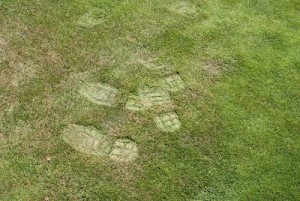Turfgrass, like all plants, requires water for growth and survival. With the weather we’ve been having lately, watering your lawn is probably the last thing on your mind.

However, without sufficient rainfall, water to home lawns will need to be supplemented with irrigation. The most efficient way to irrigate or water your lawn is to apply water only when the lawn starts to show signs of drought stress from lack of moisture.
A few signs associated with drought stress include the changing of turfgrass color from green to a bluish-gray, or white cast. Another sign could be “footprints” on the lawn. If walking across a lawn late in the afternoon causes footprints to be left behind, the lawn may need watering. When feet compress the leaf blades of the turfgrass, the low water levels in the plant tissue prevent the leaf blades from recovering, or “springing” back up, after being pushed down. If the footprints remain for an extended period of time, water the lawn to prevent the turfgrass from turning brown and becoming dormant. The visual condition of the turfgrass can also be used to evaluate drought stress. Turfgrass blades respond to drought stress by folding, rolling, and/or wilting.
A recommended application of ½ to ¾ inch of water can be applied when your turfgrass begins to show the drought stress symptoms discussed previously. Once this amount of water is applied, do not apply again until drought is noticeable. If it rains, like it has been lately, hold off on irrigating until visible drought stress symptoms appear.
Irrigation frequency can vary based on grass species, rainfall amounts, soil type and amount of compaction, shade presence, location, etc. There is a fine line between under and over watering a lawn. Over watering can cause problems such as poor root growth and susceptibility to disease. Over watering can also increase the presence of weed species. When watering, avoid applying water to the point of runoff. Allow the water to soak into the lawn and soil. The optimal time of day to water lawn grass is during the early morning hours. If irrigation is done during the day that water is being lost to higher evaporation rates. Watering in late afternoon or late morning may be detrimental if it extends the time the lawn is naturally wet from dew. This extended “dew period” may increase disease presence in turf.
Automated irrigation systems are convenient, but can have flaws. Always check to make sure your system is working properly and is applying the correct amount of water. However, if significant rainfall has fallen for the week, the automated timed irrigation systems can be turned off so water is not wasted.
Once turf has been watered, it should not be watered again until similar drought stress symptoms are observed. It is never suggested to water your lawn every day, unless it is in the establishment phase or renovations are occuring. Proper watering techniques are key to creating a happy and healthy lawn.
 0
0
